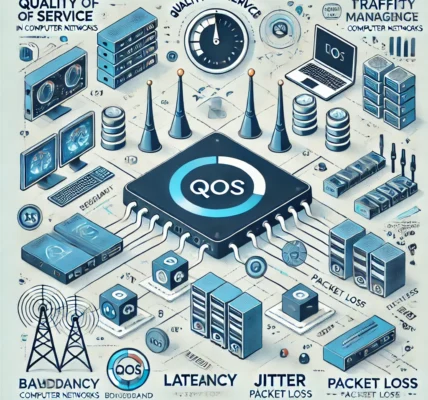What is Quality of Service (QoS)? – A Detailed Explanation
Quality of Service (QoS) refers to the overall performance level of a network, particularly the guarantee of certain levels of performance for critical data flows. In the realm of networking and communications, QoS is a set of technologies and techniques that work to manage network traffic to ensure that critical applications, services, and data transmissions receive adequate bandwidth, reduced latency, minimal jitter, and controlled packet loss. It plays a crucial role in maintaining efficient and reliable communications, especially in IP-based networks.
The Purpose of QoS
In networks that carry multiple types of traffic, such as voice, video, and data, ensuring smooth and consistent delivery of services is paramount. QoS addresses this by prioritizing specific types of traffic that are more sensitive to delays (e.g., voice and video conferencing). Without QoS, all types of data might compete for network resources equally, leading to congestion, delays, and a poor user experience, especially for real-time applications like VoIP (Voice over IP) and online gaming.
For instance, a video call or VoIP service requires real-time data transmission with minimal delays to provide a seamless experience. In contrast, file downloads or web browsing can tolerate some delay without significantly impacting the user experience. QoS ensures that time-sensitive services are given priority over less critical ones.
Key QoS Metrics
There are several performance metrics that QoS focuses on improving:
- Bandwidth: The amount of data that can be transmitted across a network within a specific time frame. QoS ensures that sufficient bandwidth is allocated to high-priority services.
- Latency: The time it takes for data to travel from the source to the destination. QoS works to minimize latency, particularly important in applications like voice or video communications where even slight delays can disrupt the flow.
- Jitter: The variability in packet arrival times. Inconsistent packet delivery times can result in poor-quality voice and video transmission. QoS aims to minimize jitter for smooth streaming and communication.
- Packet Loss: The percentage of data packets lost during transmission. QoS helps reduce packet loss, which is critical for maintaining data integrity in real-time applications.
How QoS Works
QoS operates by classifying network traffic into categories based on the importance of the data and the type of service required. Once classified, QoS can apply different rules to manage how data is treated as it traverses the network.
- Traffic Classification: Different types of data are classified based on their level of importance or sensitivity to delays. For example, voice and video packets might be classified as high-priority, while file downloads or email could be assigned a lower priority.
- Prioritization: Once classified, the network applies different levels of priority to the data packets. High-priority traffic gets expedited treatment, ensuring minimal latency and faster transmission. Lower-priority traffic may be delayed or throttled to free up resources for more critical data.
- Traffic Shaping and Policing: QoS uses techniques like traffic shaping, which adjusts the rate of data transmission to match the network’s capacity. Policing ensures that high-priority traffic does not exceed its allocated bandwidth, which could result in congestion and packet loss.
- Queuing: Data packets are placed into different queues based on their priority. Higher-priority queues are processed faster, while lower-priority packets might experience delays during network congestion.
- Congestion Management: In scenarios where network resources are scarce, QoS ensures that high-priority traffic is handled first, while less critical data may be delayed or dropped. This congestion management is crucial for ensuring that critical services, such as VoIP or real-time video, are not disrupted by high network usage.
QoS in Unified Communications
Unified Communications (UC) platforms rely heavily on real-time data, such as voice and video, which are extremely sensitive to delays, jitter, and packet loss. QoS is essential in UC environments to ensure that these real-time communications are delivered with high quality and minimal disruptions.
Without QoS, a UC system could suffer from performance issues such as dropped calls, choppy video streams, or lag during audio conversations. For instance, during peak network usage, file downloads or email services could consume available bandwidth, making it difficult for VoIP or video conferencing services to maintain real-time communication. With QoS, these real-time applications are given priority, ensuring smooth communication even under high network loads.
QoS Protocols and Standards
Several protocols and technologies are used to implement QoS in IP networks:
- Differentiated Services (DiffServ): DiffServ is a protocol for specifying and controlling network traffic by classifying and managing different types of traffic. It assigns different priority levels to packets and allows for scalable service differentiation.
- Integrated Services (IntServ): IntServ provides a mechanism for reserving resources across a network to guarantee a certain level of service for a data stream. It is often more complex to implement but provides strong QoS guarantees.
- 802.1p: This standard is used in Ethernet networks to define traffic classes and priority levels, allowing for more efficient packet handling by network switches.
- MPLS (Multiprotocol Label Switching): MPLS is a high-performance telecommunications protocol that directs data from one node to the next based on short path labels rather than long network addresses. It integrates QoS by enabling the creation of traffic engineering rules that prioritize critical data flows.
Benefits of QoS
- Improved User Experience: With QoS in place, users enjoy better call quality, smoother video streams, and faster response times for critical applications.
- Efficient Bandwidth Usage: By prioritizing traffic based on importance, QoS ensures that bandwidth is used efficiently and that critical services always have the resources they need.
- Minimized Downtime: In case of network congestion, QoS helps minimize disruptions by ensuring that high-priority traffic continues to flow, reducing the likelihood of dropped calls or interrupted services.
- Increased Reliability: QoS provides better network reliability, especially for time-sensitive services like VoIP, video conferencing, and online gaming.
Conclusion
Quality of Service (QoS) is a crucial element in modern networking, especially in environments with multiple traffic types, such as unified communications. By prioritizing critical traffic and ensuring reliable delivery, QoS helps maintain high performance, minimize disruptions, and provide a superior user experience for time-sensitive applications. As networks grow more complex and handle increasing amounts of data, QoS will continue to be a key technology in ensuring that communication services are fast, efficient, and reliable.



